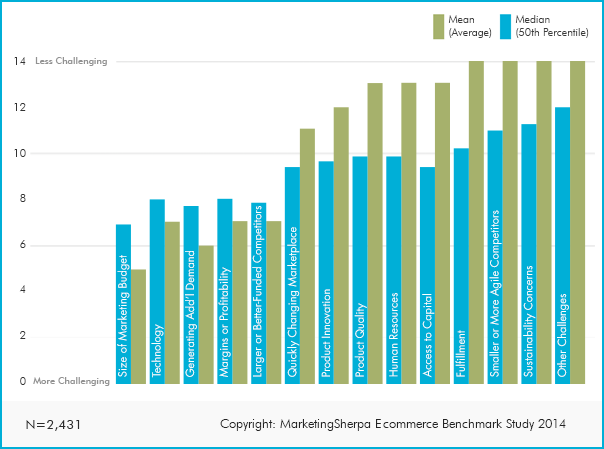by
Daniel Burstein, Director of Editorial Content
In the
MarketingSherpa Ecommerce Benchmark Study survey, we asked:
Q. Please rate the following issues from most to least challenging for your company's ecommerce operation.
Click here to see a printable version of this chart
Note: The data has been weighted to reflect the composition of the adult population. Propensity score weighting was used to adjust for respondents’ propensity to be online.When reading this chart, keep in mind that the lower bars indicate the biggest challenges, since No. 1 represents the biggest challenge and No. 14 is the least challenging aspect.
The biggest overall challenge was the size of marketing budget, something we’ve heard for many years from marketers. The mean (average) was below the median (50 percentile), indicating that there were likely many companies listing the size of the marketing budget as their top overall challenge, dragging down the average.
I’m not sure if this is because marketing departments are perennially underfunded or because marketers are aspirational. We are always just one new tool, one key hire, one big media buy away from success … if only our budgets were larger.
Either way, the bigger question you’re likely facing is, "How do you overcome these barriers to growth?" To help you do that, here are case studies and other resources that can provide the inspiration and information you need to overcome some of the top challenges marketers are facing and help grow your company.
Size of marketing budget
First, it’s good to know what size your marketing budget should be. This information is a little dated (published in 2010) and is focused on B2B companies, but might help you get a ballpark of other companies’ budgets:
Marketing Budgets by Organization SizeNext, if you decide you need a bigger budget, you need to decide where to invest. Here is a look at how your peers are investing their budgets:
Marketing Research Chart: How are marketing departments allocating budgets?Lastly, you need to make the case for a bigger budget to your director, your CEO, your investors, your clients — whoever controls the purse strings:
Ecommerce Research Chart: How marketing budgets are changing for successful companiesIf you can’t secure a bigger budget, you must do more with less, like this recruiting software company:
Inbound Marketing: How a software company generated 190% more leads with a small budgetTechnology
To oversimplify an inherently complex topic, there are two main challenges when it comes to technology. First, you must select the right technology for your company. Whether that’s an email service provider:
Marketing Technology: 4 essential steps when choosing an email service provider … or a marketing automation solution or agency:
Vendor Selection: A 5-step process for choosing a marketing automation solution or agencyTo get ideas on putting these tips into action, you can see how one of your peers chose the right technology:
Vendor Selection: How The New York Public Library chose a new email service providerAnd once you have the technology in place, you must find novel ways to use it to best serve the customer:
How to Harness the Power of New Technology to Personalize to Your AudienceGenerating additional demand
There are as many ways to generate additional demand as there are stars in the sky. From email personalization:
Email Personalization: 750% higher CTR and more revenue for ecommerce site… to content marketing:
How Wine Enthusiast increased organic traffic 154% with content marketing… to, well, if there is a tactic you’re interested in, we’ve probably written a case study about it. Simply search our library:
Search the MarketingSherpa Library… or read this blog post, which sums up several ecommerce case studies in one place:
Ecommerce: 10 case studies to help you excel in content marketing, social media and website optimizationMargins and profitability
How do your margins compare to your peers? Here is data about the margins of 413 ecommerce companies:
Ecommerce Research Chart: Average gross margins for small, medium and large companiesIf your margins are too thin, it may be because your value proposition to your customers isn’t compelling enough and you are overly reliant on discounts, promotions and other incentives:
Value Proposition: A free worksheet to help you win arguments in any meetingTo determine the ideal value proposition, you can conduct A/B testing. This is an advantage ecommerce sites have over brick-and-mortar companies. If you aren’t testing yet, start now. Heck, eBags has been testing since way back in 2001:
eBags Raises Home Page Profitability By Splitting Traffic to TestsJust make sure you’re not running random tests without an overall goal. Make sure you have a test plan in place to actually learn what really resonates with your customers:
Value Proposition: 3 steps for laying your value prop testing groundworkAnd if you need more help with your value proposition, there is an entire course on the topic from MarketingSherpa’s parent company, MECLABS Institute:
Online Course: Value Proposition DevelopmentLarger or better-funded competitors
Bigger companies seem to have all the advantages. But take heart — smaller companies are nimbler and upstarts can transform an industry, especially the companies that can leverage digital media well.
To inspire you to battle Goliath, here’s one case study I love about how a small SaaS company used content to gain an outsized amount of attention at a major event, even though it was a much smaller sponsor in the industry:
Tradeshow Marketing: Why a SaaS company helped competitors generate leads










